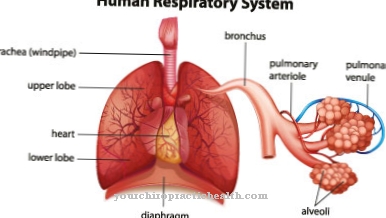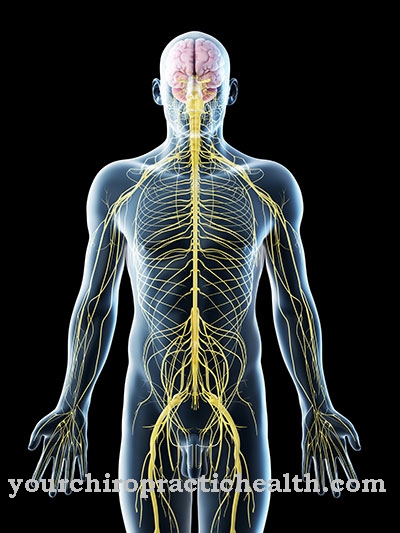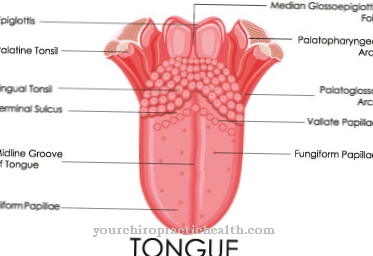Usually it is Chondropathia patellae a favorable cartilage disease of the knee. Surgical therapy measures are very rarely necessary.
What is chondropathia patellae?

Chondropathia patellae is a disease of the cartilage (chondropathy) that affects the back of the kneecap (patella). If the knee is affected by chondropathia patellae, the articular cartilage usually shows degenerative impairments.
Chondropathia patellae mainly affects young women and girls. If chondropathia patellae is present in boys, these are usually found in the phase of puberty. In the majority of cases, when a person has chondropathia patellae, both knees are affected by the condition.
Chondropathia patellae is characterized by pain in the affected knee, which can be seen, for example, when the affected person stands up after sitting for a long time, climbs or descends stairs, or walks downhill.
causes
Chondropathia patellae is caused by changes in the back cartilage of the kneecap. Such changes alone, however, usually do not cause the pain associated with chondropathia patellae.
The typical pain of chondropathia patellae often occurs when, in addition to the changes in the cartilage of the knee, frequent overloading of the knee (for example through frequent kneeling activities) or the adjacent tendons (for example through sudden stopping movements of the knee, such as those that occur when walking downhill, for example) ) are available.
In addition to overloading, other factors can also cause chondropathia patellae: for example, malfunctions of the ligaments on the knee joint, misalignments of the kneecap or impairment of the thigh muscles. Injuries or accidents in which one or both knees are affected can also lead to chondropathia patellae.
You can find your medication here
➔ Medicines for joint painSymptoms, ailments & signs
In most cases, chondropathia patellae leads to a positive course of the disease and thus no permanent damage and no complications. Treatment is not necessary in every case, as the disease heals on its own in many cases. Patients with chondropathia patellae have severe pain in their knees.
The pain occurs mainly in the area of the kneecap and can significantly limit the everyday life of the person affected and reduce the quality of life. The pain can be very severe, especially when exposed to stress, and thus lead to restricted mobility. In some cases, patients are dependent on walking aids or the help of other people in their lives.
Pain can also occur at night, which has a negative effect on the sleep quality of the person concerned and can thus lead to irritability or other psychological complaints or depression. However, life expectancy remains unchanged. In children, chondropathia patellae can also lead to restrictions or delays in growth and development, which can be quickly corrected. Usually there are no other complaints.
diagnosis
In order to be able to make the diagnosis of chondropathia patellae, a treating specialist usually first talks to the patient in order to obtain information about the individual symptoms and their course.
As part of a physical examination, it can then be checked, for example, whether the affected knee is experiencing pressure pain typical of chondropathia patellae. Ligaments, tendons and adjacent muscles of the knee are also usually checked if chondropathia patellae are suspected.
A diagnosis can be confirmed by procedures such as x-rays, magnetic resonance tomography or, more rarely, a joint endoscopy. The course of chondropathia patellae is usually favorable: in many cases it heals independently after a few weeks.
Complications
In most cases there are no complications with chondropathia patellae. The disease usually heals quickly and no medical intervention is necessary. Chondropathia patellae cause severe pain in the patient's knees.
These occur mainly after exercise, but can also make themselves felt in the form of resting pain. Everyday life is severely restricted by the pain, so that the patient also suffers from restricted mobility. The pain at rest can also occur at night and lead to sleep disorders and increased irritability. Usually there are no other complaints.
However, the pain can also cause the person concerned to become mentally ill and suffer from depression. The treatment of chondropathia patellae takes place in most cases through therapies. Various exercises are carried out with the patient to alleviate the symptoms and protect the joints.
The patient must avoid high stress or sporting activities. Severe pain is treated with the help of pain relievers. Surgical intervention is only necessary in very serious cases. Even after the treatment, the affected person is restricted in his everyday life by the chondropathia patellae and must avoid stress. There are no further complications.
When should you go to the doctor?
If you experience pain in the kneecap and other typical signs of chondropathia patellae, a doctor is recommended. If the cartilage disease is not treated, further complaints such as nighttime pain can arise - at the latest then a doctor should be consulted. If you have bad posture and muscle tension, it is best to see a chiropractor or orthopedic surgeon. Patients who have already had chondropathia patellae should contact the responsible doctor if the symptoms recur.
Recurring symptoms can lead to osteoarthritis of the kneecap in the long term and must therefore be clarified. People who regularly kneel or otherwise overload the tendons on the kneecap are particularly at risk. There is also an increased risk of cartilage disease with existing malfunctions of the muscles and ligaments in the knee joint as well as malformations and malpositions of the kneecap. Anyone who belongs to these risk groups should have these complaints clarified quickly. Patients who suffer from kneecap pain after an accident should, at best, speak to the responsible doctor immediately.
Doctors & therapists in your area
Treatment & Therapy
In the majority of cases, chondropathia patellae can be adequately treated with conservative (non-surgical) treatment methods. The focus of the treatment of chondropathia patellae is primarily on physiotherapeutic (physiotherapeutic) measures which, among other things, aim to strengthen the anterior thigh muscles.
In addition, doctors recommend taking sufficient care of the affected knee joint in the event of chondropathia patellae. This can be achieved, for example, by applying stabilizing bandages and by avoiding movements that put too much strain on the knees (such as squats).
If very severe pain occurs in connection with chondropathia patellae, pain-relieving medication may be necessary in rare cases. This can be done with the help of tablets. Surgical intervention is only necessary in rare cases for chondropathia patellae.
If a chondropathia patellae has been successfully treated, experts believe that it can make sense not to put too much strain on the affected knee over a long period of time; Hobby athletes can switch to recreational sports such as cycling or swimming, which are easy on the knee joints. In women who have suffered from chondropathia patellae, temporarily avoiding shoes with high heels.
Outlook & forecast
Chondropathia patellae have a good chance of healing. In most patients, the symptoms regenerate within a short time after relieving the knee. Complete remission is possible after a few weeks. Consequences are normally not to be expected.
The path to healing is shortened as soon as a few pointers are observed. Due to the natural self-healing powers, recovery is possible in many cases without medical treatment. The healing process is also shortened with medication. The prognosis also improves if the patient wears healthy shoes and takes sufficient rest and periods of rest.
The recurrence of chondropathia patellae is possible at any time. Nevertheless, by taking precautionary measures, the patient can actively influence this and prevent its recurrence. With the right precautions, there is a chance that permanent healing will occur. Sufficient fitness, avoidance of obesity and a healthy lifestyle are important for this.
As soon as the person concerned optimizes his lifestyle, he usually remains cured. In rare cases, the symptoms may worsen. If the knee is put under constant stress or if the knee is subjected to repeated heavy use, the pain remains. This can result in muscle problems or poor posture in the skeletal system.
You can find your medication here
➔ Medicines for joint painprevention
Direct prevention of chondropathia patellae is only possible to a very limited extent. The risk of developing chondropathia patellae can, however, be reduced by avoiding overloading the knees at an early stage. Active athletes who already feel slight knee problems are recommended as a possible preventive measure against chondropathia patellae, for example, to stabilize the affected joint, to protect it and to avoid sports with a high risk of falling.
Aftercare
The healing process for chondropathia patellae can be positively influenced by consistent follow-up care. Nevertheless, with conservative therapy a regeneration phase of up to six months can be expected. As part of the follow-up treatment, the doctor recommends targeted physiotherapy. After a precise briefing by a professional, the patients can also do the exercises at home. Avoid overloading the knee during the build-up phase.
This means that intense exercise and climbing stairs are taboo for a certain period of time. Depending on the severity of the disease, the doctor will prescribe anti-inflammatories. Patients may also wear knee bandages in order to avoid incorrect loads. Electrotherapy and strengthening exercises can lead to increased symptoms for a short time.
In this way, those affected should not let themselves be unsettled, but rather stick with the program to the end. In general, the regeneration process is quite positive. This also applies to the time after surgery. Here it is important that the patient raise their leg as often as possible and only start the activities slowly. This starts with gentle walking, slow swimming, and cycling. Excessive squats during sporting activities and around the house should be avoided in the beginning.
You can do that yourself
Chondropathia patellae is a disease of the cartilage of the kneecap that is sometimes very painful. Children and young girls and women are often affected. The up to seven millimeters thick cartilage on the inside of the kneecap is supplied by the joint fluid (synovia) in the knee joint.
This assumes, among other things, that the kneecap experiences a certain contact pressure from the muscles and ligaments within certain tolerances and is exposed to pushing movements with changing loads due to movements of the knee. Inclined loads due to poor posture or muscle degradation of the most important leg extensor, the quadriceps femoris muscle, can lead to painful damage to the knee cartilage.
In contrast to earlier when mainly rest was prescribed, targeted gymnastics is recommended today, which those affected can do themselves. Great emphasis is placed on the development of the leg muscles. Above all, the extensor muscles on the thigh should be able to provide the kneecap with the “correct” contact pressure and to provide it with nutrients through the natural knee movement via the synovia.
This means that targeted physiotherapy and physiotherapy are very important self-help measures in order to be pain-free again as soon as possible. In addition to the individually compiled exercises, muscle building is also of similar importance. Recommendations for absolute protection of the knee are usually not effective according to modern knowledge.




.jpg)

.jpg)




















